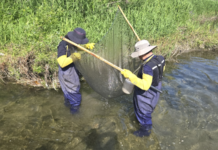Producing mushrooms using the bottle cultivation method, each species of mushroom requires its own specific level of moisture and its own culture size. Researchers have now fine-tuned their understanding of bottle cultivation and can produce mushrooms under even more ideal circumstances, depending on the species.
Since 2013, the Rural Development Administration has been researching how much soil has to be put in the bottle and how much moisture should be in the soil in order to grow the fungus under ideal conditions, specifically the enoki mushroom (Flammulina velutipes), the king trumpet mushroom (Pleurotus eryngii) and the oyster mushrooms (Pleurotus ostreatus). Those three species account for more than 70 percent of the overall number of mushrooms grown in the nation.

Enoki mushrooms are grown through the bottle cultivation method.
As a result of their research, they found that the culture soil, consisting mainly of sawdust, corn cobs, cottonseed husks, rice bran, wheat skin and beet pulp, that is used in the cultivation of each of the three types of mushrooms should have a different level of quantity, moisture absorption and, also, expansion and contraction capability by moisture.
In addition, to have a proper gap between soil particles, a factor that allows the mushrooms to grow healthily, it’s imperative to control the moisture content, too. For oyster mushrooms, which need a relatively small amount of culture medium, adding beet pulp and cottonseed meal in the soil is ideal, as the ingredients are easy to expand through the agency of moisture and, also, are rich in nitrogen.
Meanwhile, when rice bran and wheat bran are used in the soil for enoki mushrooms and king trumpet mushrooms, respectively, it creates a proper gap between soil particles.
The recent study also found that the proper moisture content in the soil and the proper amount of soil required on a 1,100-milliliter basis comes to 66 to 68 percent and 680g to 710g for the king trumpet mushroom, 69 to 71 percent and 600g to 650g for the oyster mushroom and, lastly, 64 to 66 percent and 700g to 720g for enoki mushrooms.
For example, if 10,000 bottles of enoki mushrooms are cultivated per day under the same conditions, these results could save farmers about KRW 10 per bottle on the cost of making the culture soil. Production would increase by 11.6 percent, in turn leading to an increase in annual profits up to about KRW 15.8 billion across the nation, researchers estimate.
“Farmers have so far been using their own methods to grow mushrooms, but output is different in terms of both quantity and quality,” said an official from the Rural Development Administration. “Now that we have this new approach to make the best possible environment to help the mushrooms grow, farmers will be able to properly control the moisture content, the quality of the culture soil and the gap in their soil particles. This will surely make for more stable production of mushrooms of good quality throughout the year.”
By Sohn JiAe
Korea.net Staff Writer
Photo: the Rural Development Administration
jiae5853@korea.kr























